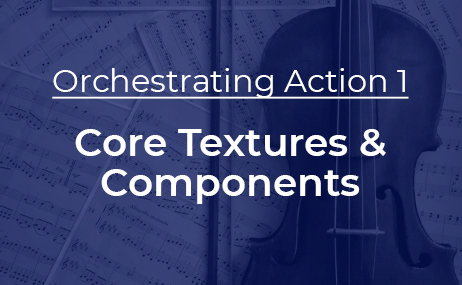
Since I started creating courses on Film Music Notes back in 2021, many people have asked me when I’m going to do a course on the orchestration of action music like in classic blockbuster films. Well, I’m happy to say I’ve finally released the first of these courses, Orchestrating Action 1: Core Textures and Components. I feel this is a special course in my repertory, because it had to be created over a long time entirely from original ideas. Not wanting to disappoint my fans, I was determined to make just such a course. So here’s the story of how it came into being.
While I’ve had academic training in the gamut of subjects in music theory, how to use the orchestra to create certain moods or meanings just wasn’t part of the curriculum. Of course, we were taught the instruments in the orchestra, their characteristics, and how to write for each of them and what tends to sound good together, but when it came to putting them all together into a whole that had a certain meaning, there was a distinct lack of literature on the subject.
I knew that I needed to take the time to come up with a set of ideas from scratch. So I took my own research sabbatical to study many of the most beloved action cues from classic blockbuster films – over 50 in total, a process that took 2 and a half months. That was just for the research. Actually making these ideas into a course took another 3 and half months, so it took quite a while at 6 months overall, but it was a journey that I really couldn’t be happier with, and I hope that you’ll find the same.
What really cracked it open for me was coming up with just 5 action-texture components, especially the continuous rhythmic element called the motor rhythm, or simply the motor. I started to notice that cues with similarly-scored motors had similar uses in the narrative. Like notice how in this track from Star Wars, the timpani has a motor of one note per beat and the trumpets have a mid-to-high melody overtop:
And compare that to this track from Raiders of the Lost Ark, where the timpani and snare drum have again a one-note-per-beat motor, and the brass have a mid-to-high melody overtop:
And the thing is, in both of these scenes, the heroes are being pursued by a large army. This kind of texture became one of the main texture families in the course – the Large or Powerful Enemy family.
And so it went until I had developed a full-blown course of over 7 hours with nearly two dozen textures divided into four texture families. That’s a lot of textures! Now I had to make sure the ideas actually worked. So I wrote my own action cue using the concepts in the course and was quite pleased with the results. Here’s a short sample of what I came up with:
So if you’re one of the many fans who are interested in classic action orchestration, I very much hope that in taking this course, you get a lot out of it, and are able to build up and understand classic action textures in a way that is both new and especially meaningful.
Fantastic work, Mark! Thanks for taking the time to put together this course. It’s very much appreciated. 🙂
I’ve gone through the first section of the course “Neutral/Battle Chase Textures” and I am as always amazed by your ability to break concepts down into digestible units. Breaking the orchestration down into their functions and demonstrating them through the audio is outstanding. Once again, you have created an amazing course, and I am looking forward to continuing the journey.
What an accomplishment! I can’t wait to get into this one! Your focus on the emotional meaning of musical choices really sets your teaching apart.
Mark, this is incredible. I love that you’re breaking new ground in the world of music analysis with this texture-first approach.
I’ve only started on the first set of lessons but i’m already very excited about how the course will change my compositions for the better, as your other courses have already done.
Matching textures to expression – I’m pretty sure there is nobody else even coming close to this. Certainly not online.
Great stuff. 🙇
Not enough time in the day to dive in as deeply as I’d like, but I can’t wait to jump into this course! Having studied composition in school, I must agree with Mark that there is a genuine dearth of subject matter on how to orchestrate around “textures.” I imagine there are quite a few similar techniques employed by the masters, each with their spin, but using the same technique tree.